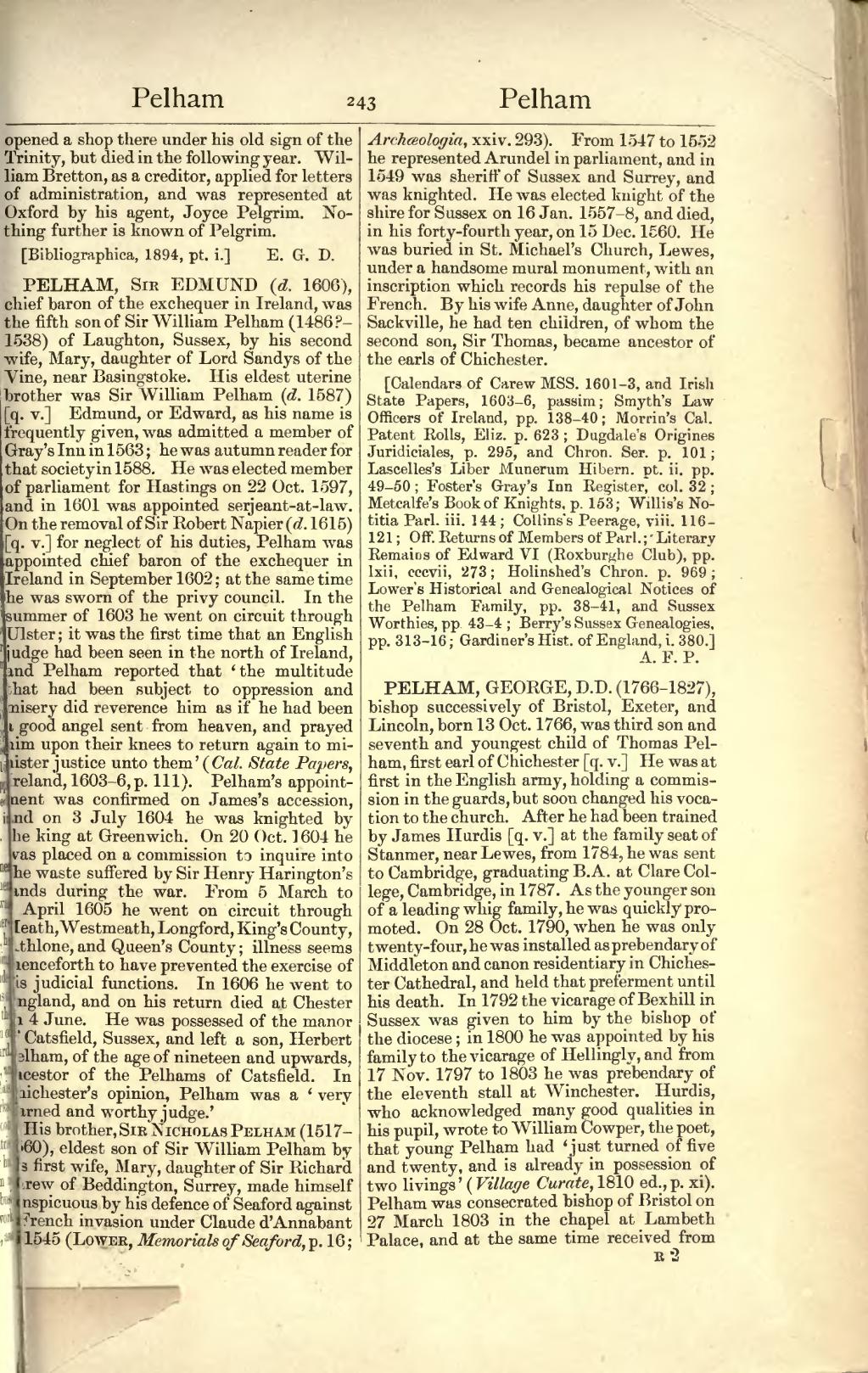opened a shop there under his old sign of the Trinity, but died in the following year. William Bretton, as a creditor, applied for letters of administration, and was represented at Oxford by his agent, Joyce Pelgrim. Nothing further is known of Pelgrim.
[Bibliographica, 1894, pt. i.]
PELHAM, Sir EDMUND (d. 1606), chief baron of the exchequer in Ireland, was the fifth son of Sir William Pelham (1486?–1538) of Laughton, Sussex, by his second wife, Mary, daughter of Lord Sandys of the Vine, near Basingstoke. His eldest uterine brother was Sir William Pelham (d. 1587) [q. v.] Edmund, or Edward, as his name is frequently given, was admitted a member of Gray's Inn in 1563; he was autumn reader for that society in 1588. He was elected member of parliament for Hastings on 22 Oct. 1597, and in 1601 was appointed serjeant-at-law. On the removal of Sir Robert Napier (d. 1615) [q. v.] for neglect of his duties, Pelham was appointed chief baron of the exchequer in Ireland in September 1602; at the same time he was sworn of the privy council. In the summer of 1603 he went on circuit through Ulster; it was the first time that an English judge had been seen in the north of Ireland, and Pelham reported that ‘the multitude that had been subject to oppression and misery did reverence him as if he had been a good angel sent from heaven, and prayed him upon their knees to return again to minister justice unto them’ (Cal. State Papers, Ireland, 1603–6, p. 111). Pelham's appointment was confirmed on James's accession, and on 3 July 1604 he was knighted by the king at Greenwich. On 20 Oct. 1604 he was placed on a commission to inquire into the waste suffered by Sir Henry Harington's lands during the war. From 5 March to 5 April 1605 he went on circuit through Meath, Westmeath, Longford, King's County, Athlone, and Queen's County; illness seems thenceforth to have prevented the exercise of his judicial functions. In 1606 he went to England, and on his return died at Chester on 4 June. He was possessed of the manor of Catsfield, Sussex, and left a son, Herbert Pelham, of the age of nineteen and upwards, ancestor of the Pelhams of Catsfield. In Chichester's opinion, Pelham was a ‘very learned and worthy judge.’
His brother, Sir Nicholas Pelham (1517–1560), eldest son of Sir William Pelham by his first wife, Mary, daughter of Sir Richard Carew of Beddington, Surrey, made himself conspicuous by his defence of Seaford against a French invasion under Claude d'Annabant in 1545 (Lower, Memorials of Seaford, p. 16; Archæologia, xxiv. 293). From 1547 to 1552 he represented Arundel in parliament, and in 1549 was sheriff of Sussex and Surrey, and was knighted. He was elected knight of the shire for Sussex on 16 Jan. 1557–8, and died, in his forty-fourth year, on 15 Dec. 1560. He was buried in St. Michael's Church, Lewes, under a handsome mural monument, with an inscription which records his repulse of the French. By his wife Anne, daughter of John Sackville, he had ten children, of whom the second son, Sir Thomas, became ancestor of the earls of Chichester.
[Calendars of Carew MSS. 1601–3, and Irish State Papers, 1603–6, passim; Smyth's Law Officers of Ireland, pp. 138–40; Morrin's Cal. Patent Rolls, Eliz. p. 623; Dugdale's Origines Juridiciales, p. 295, and Chron. Ser. p. 101; Lascelles's Liber Munerum Hibern. pt. ii. pp. 49–50; Foster's Gray's Inn Register, col. 32; Metcalfe's Book of Knights, p. 153; Willis's Notitia Parl. iii. 144; Collins's Peerage, viii. 116–121; Off. Returns of Members of Parl.; Literary Remains of Edward VI (Roxburghe Club), pp. lxii, cccvii, 273; Holinshed's Chron. p. 969; Lower's Historical and Genealogical Notices of the Pelham Family, pp. 38–41, and Sussex Worthies, pp. 43–4; Berry's Sussex Genealogies, pp. 313–16; Gardiner's Hist. of England, i. 380.]
PELHAM, GEORGE, D.D. (1766–1827), bishop successively of Bristol, Exeter, and Lincoln, born 13 Oct. 1766, was third son and seventh and youngest child of Thomas Pelham, first earl of Chichester [q. v.] He was at first in the English army, holding a commission in the guards, but soon changed his vocation to the church. After he had been trained by James Hurdis [q. v.] at the family seat of Stanmer, near Lewes, from 1784, he was sent to Cambridge, graduating B.A. at Clare College, Cambridge, in 1787. As the younger son of a leading whig family, he was quickly promoted. On 28 Oct. 1790, when he was only twenty-four, he was installed as prebendary of Middleton and canon residentiary in Chichester Cathedral, and held that preferment until his death. In 1792 the vicarage of Bexhill in Sussex was given to him by the bishop of the diocese; in 1800 he was appointed by his family to the vicarage of Hellingly, and from 17 Nov. 1797 to 1803 he was prebendary of the eleventh stall at Winchester. Hurdis, who acknowledged many good qualities in his pupil, wrote to William Cowper, the poet, that young Pelham had ‘just turned of five and twenty, and is already in possession of two livings’ (Village Curate, 1810 ed., p. xi). Pelham was consecrated bishop of Bristol on 27 March 1803 in the chapel at Lambeth Palace, and at the same time received from
